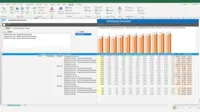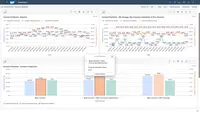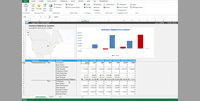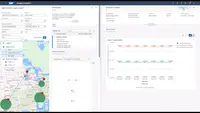Overview
What is SAP Integrated Business Planning?
SAP supports supply chain management with Integrated Business Planning, the company's real-time cloud-based supply chain planning platform supporting demand response, supply planning and inventory management oriented features, with supply chain analytics to support decisioning.
Awards
Products that are considered exceptional by their customers based on a variety of criteria win TrustRadius awards. Learn more about the types of TrustRadius awards to make the best purchase decision. More about TrustRadius Awards
Popular Features
- Demand forecasting (19)7.676%
- Resource optimization (18)7.575%
- Scenario-based planning (19)7.171%
- Custom alerts (19)6.262%
Reviewer Pros & Cons
Pricing
Entry-level set up fee?
- Setup fee optional
Offerings
- Free Trial
- Free/Freemium Version
- Premium Consulting/Integration Services
Would you like us to let the vendor know that you want pricing?
28 people also want pricing
Alternatives Pricing
Features
Product Details
- About
- Competitors
- Tech Details
- Downloadables
- FAQs
What is SAP Integrated Business Planning?
A software solution that helps users respond to new market expectations with real-time supply chain planning capabilities, and fulfill future demand profitably. Powered by in-memory computing technology within SAP HANA, this cloud-based solution combines capabilities for sales and operations, demand, response and supply planning, and inventory optimization. - Cloud deployment - Real-time scenarios and simulation - Social collaboration - Predictive Analytics
Key Capabilities: Offers end-to-end visibility of the supply chain, decision support, and supports corrective action through integration with SAP Supply Chain Control Tower. It provides demand transparency with short-term, mid-term, and long-term forecasting, and capabilities for demand sensing and statistical forecasting. It is used in the attempt to establish optimal inventory targets that enable the business to maximize profits, while leaving a buffer to help meet unexpected demand, and to deliver a cross-departmental sales and operations plan that balances inventory, service levels, and profitability. Users can optimize resourcing efficiency by creating supply plans based on prioritized demands, allocations, and supply chain constraints.
Key Benefits: Achieve a rapid deployment Get up and running quickly with SAP Integrated Business Planning by using preconfigured process templates for an accelerated implementation. Empower employees with intuitive features Offer a unified, intuitive user experience with SAP Fiori and planning and simulation capabilities based on Microsoft Excel. Plan resources effectively Optimize resource efficiency by creating supply plans based on prioritized demands, allocations, and supply chain constraints.
SAP Integrated Business Planning Features
Supply Chain Planning Features
- Supported: Custom alerts
- Supported: Scenario-based planning
- Supported: Resource optimization
- Supported: Supply forecasting
- Supported: Capacity estimation
- Supported: Supply network coordination
Demand Management Features
- Supported: Demand signal sensing
- Supported: Demand forecasting
- Supported: Customer analytics
- Supported: Inventory stock optimization
- Supported: Sales and operations planning
- Supported: Pricing and promotion tracking
SAP Integrated Business Planning Screenshots
SAP Integrated Business Planning Videos
Watch Short overview video
SAP Integrated Business Planning Competitors
SAP Integrated Business Planning Technical Details
| Deployment Types | Software as a Service (SaaS), Cloud, or Web-Based |
|---|---|
| Operating Systems | Unspecified |
| Mobile Application | No |
| Supported Countries | Global |








